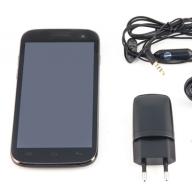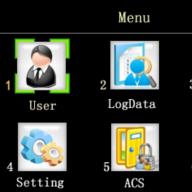To configure the keyboard, you need to:
Go to the “Start” menu → “Control Panel” → click on the “Keyboard” icon (if the menu is in classic view) or select the “Printers and other equipment” category (if the menu is displayed by category) and then click “Keyboard” → the window “ Properties: Keyboard".
In the "Properties: Keyboard" window on the "Speed" tab:
- In the “Delay before repeating” item, you can set the time interval after which the characters will begin repeating if you hold the keys pressed. It is recommended to select “Shorter” to speed up typing.
- In the “Repeat speed” item, you can select the speed of entering repeated characters if you hold the key pressed. It is recommended to select “Higher” for faster typing.
- In the “Cursor flickering frequency” item, you can adjust the flickering speed of the text output cursor. There are no general recommendations, act according to your preferences.
After the basic settings are made, close the window with the “OK” button.
Setting language input options
To configure language input settings, that is, set which default language will be used when the computer boots, you must:
Right-click on the keyboard layout language bar icon on the taskbar → “Options” → in “Default input language” select a language.
If you click the “Keyboard Options” button, you can configure additional keyboard parameters (which key to turn on and off the Caps Lock, and also assign the keyboard shortcuts you want to use to switch between input languages - usually used Alt left + Shift).
Note:
If you don't see the Language Bar, right-click an empty space on the taskbar, select Toolbars, and then click the Language Bar button.
To configure additional language support with writing from right to left and writing hieroglyphs, you need:
go to the “Start” menu → “Control Panel” → “Switch to classic view” → “Language and Regional Standards” → in the window that appears, click the “Language” tab → the “Languages and text input services” item → the “More details” button. There you will find the appropriate setting.
Has the mouse failed? Master keyboard control
While the mouse is still functional, practice controlling the mouse pointer using the keyboard.
- Bring up the Start menu by pressing a key Win(window key Windows in the bottom row of the keyboard.
- Using the up, down, left, and right arrows, find “Control Panel” and press the “Enter” key.
- To switch to the Mouse tab in the Accessibility window, use the keyboard shortcut Ctrl + Tab.
- You can navigate inside the Mouse tab using the Tab key. Make sure the “Settings” button is framed and press “Enter.”
- To check or uncheck a box, press the spacebar and use the arrows to move between “on” and “off.”
- When you have everything set up, press Enter, then use the Tab key to navigate to the OK button and press Enter.
Now to enable keyboard pointer control, press the key combination that was specified in the settings window:
“left Shift” + “left Alt” + “Num Lock”(simultaneously). After the beep, click “OK” in the window that appears.
An icon in the form of a crossed out “mouse” will appear in the tray on the right side of the taskbar. This means that the keyboard pointer control mode is enabled. This mode is turned off by pressing the same key combination.
The control itself is performed using the numeric keypad on the right side of your keyboard, namely using the arrow keys.
If the indicator Num Lock is active (lit green), then press the “Num Lock” key. If the indicator is not active, then keyboard control is available. Remember that you can use the Enter key instead of double-clicking the mouse.
In order for any information to appear on the computer, it must be entered using the keyboard. This particular part of a computer device is one of the most basic. There is practically no way to cope without it. Without using a mouse, the PC is very easy to operate. However, without a keyboard this is almost impossible to do. There is a special controller on the motherboard, with which the keyboard interface is closely connected.
Every user should have the knowledge of how to customize the keyboard. This is necessary to make it easier to use in performing a variety of computer tasks. Today, a keyboard can be connected to a computer device using three very different methods:
- PS/2 connector, which is standard. However, each user must remember that it cannot be turned on when the computer is turned on. This can lead to failure of an important part of the motherboard.
- Connection via USB slot. With this connection method, the keyboard’s operating principle is no different from that of the previous type.
- Wireless connection. This connection method differs from all previous ones in that it requires the operating system to start for the keyboard to work. It is after the OS boots that the drivers installed for the correct operation of the keyboard will begin to work. Only at this time is it completely ready for use.
After connecting the keyboard, you need to configure it correctly for ease of use.
Standard method for setting up a keyboard on a computer device
First you need to make the most standard keyboard settings. This can be done with great ease. You need to go to the Start section and find the Control Panel. After this, you should open the keyboard section and select keyboard properties. Then you can simply select which settings are required in a particular case.
How to adjust keyboard speed
Each computer keyboard model is created in such a way that when you press its buttons with the image of various characters, they will be repeated several times. This will repeat until the button is released by the user. However, today this parameter is being adjusted. This is done in the Repeat the entered character section.
In the Delay before repeating section, you can set the symbols to be played at certain intervals. In the dialog box, which is located in the keyboard properties, there is a line for entering text information. It can be used to check the applied settings.
In the Repeat Speed section, you can set the delay time before entering a new character. In the Cursor Flicker Frequency item, you can set the speed at which the cursor will flicker on the monitor. The slider must be moved to the right or left so that this setting subsequently has the specified parameter. When everything is configured, you will need to click on Ok.
How to set the input language
The computer system has the ability to set the default language. To do this, click on the right mouse button in the section of the toolbar indicating the input language. You should go to the back panel and find the default input language section. There you need to install the desired language.

In the keyboard settings section, you need to make additional settings. You should set which keys can be used to enable the Claps lock option. You can also specify which buttons should be used to enable a different language. In most cases, the Alt+Shift key combination is used.
To configure support for a wide variety of languages around the world, you can go to the control panel and select switching to the classic view there. You need to select your locale and language. After this, you need to go to the language section and configure it as needed.
Customizing the keyboard is very easy. This must be done. After all, this is the determining factor for ensuring ease of use of a computer device.
Video: Setting up the keyboard in Windows
Instructions
Check if the drivers for the keyboard and touchpad are installed. Go to “Device Manager” and look at the inappropriate item. Often, the Windows 7 operating system selects universal drivers that do not support additional button functions.
Go to the manufacturer's official website and find the downloads section. Download the driver for your keyboard and function keys. Install the program after scanning the downloaded files with an antivirus. After downloading any files and installing them on a personal computer, you need to fully scan the computer for virus programs that could be automatically integrated into the operating system registry.
Reboot your computer so that the changes you make to the operating system take effect the next time you log on to Windows. Test the operation of the buttons with additional functions by using the special button. To use the special function of the buttons, find the Fn button on the keyboard - it is the one that activates the additional function of the key. Hold this button and press the function key to, for example, sound the system.
You can also find drivers and descriptions of the function keys in the materials on the disk from the laptop manufacturer. Install useful utilities from the disk, including a program for processing signals from function keys. It is also worth noting that drivers must be installed for the touchpad, which completely replaces the mouse. Go to the official website of the laptop manufacturer and download special software for your operating system.
Video on the topic
Sources:
- how to configure switches
The keyboards of many laptops or netbooks have an Fn button. Why is it needed?
The keyboard of most laptops, ultrabooks and netbooks has an Fn button, but unfortunately the instructions for the gadget do not always contain a description of its use and inexperienced users, by randomly pressing it, can accidentally turn off Bluetooth or the wireless network, the touchpad, switch to the numeric keypad from the main one, and the user will think that the laptop is broken.
In fact, the Fn button is a quick access to some features and settings of the computer. We must remember that to quickly call up settings or turn a function on/off, you just need to hold down Fn and at the same time the second key - with the symbol of the function.
Take a closer look at the keyboard. In addition to letters and control buttons with the designations Enter, Shift. Ctrl, Alt, etc., on the keyboard you will find buttons with small icons drawn in the same color as the letters "Fn" (usually a more faded color than the others used in the keyboard design). By pressing Fn simultaneously with the button on which the loudspeaker is depicted, you can control the sound on and off; by pressing Fn simultaneously with the button on which the icon indicating the WiFi network is displayed, you can turn on and off the WiFi receiver-transmitter of the laptop, etc. Turning on/off the touchpad, sleep mode, adjusting screen brightness, as well as switching to working with the numeric keypad (if the laptop keyboard is not full-size) works in the same way.
It's worth understanding the functions that can be quickly controlled using the Fn button, since changing the same settings in the operating system is often much more difficult and time-consuming.
If the Fn key does not work, then it may be disabled in the BIOS. If this is not the case, you will have to install special software that comes with your specific PC model.
Example of using the Fn button: The photo shows that pressing Fn and F3 at the same time turns Bluetooth on and off.

In this article I will tell you:
- how to set up the keyboard on Android
- turn off phone vibration
- what to do if the keyboard on a Samsung smartphone is missing
- how to install a replacement for a standard keyboard (change the keyboard shell).
How to remove vibration on the Android keyboard
When you enter text, your phone vibrates. At first it is comfortable, then it slowly begins to irritate. It’s also annoying that it can’t be disabled directly in the keyboard layout settings. Here are step-by-step instructions on how to quickly turn off vibration on your Android keyboard:
- Go to Settings - General settings - section "Language and input".
- On the page that appears, select the keyboard you are using
- Scroll through the list of keyboard options and uncheck the box next to "Vibrate when typing."
If you are using Samsung, vibration can be turned off as follows:
- Settings - General settings - Language and input section
- On-screen keyboard - Samsung keyboard - Touch feedback - Vibration
- Slide the Vibration switch to the left
This is how you can turn off vibration response on most devices with the latest versions of Android. In older versions, some settings may differ, but we believe you can easily find them.
The keyboard has disappeared on Android (Samsung) - what to do?
What to do if the keyboard has disappeared on your Android (and this application is mega-important for many)? You can quickly return the keyboard on Samsung models and others to its place using one of the following methods.
Google Play has dozens of great keyboards for tablets and smartphones. Each of them can become a full-fledged replacement for a standard keyboard. Many of them are free to download, but require nominal money for add-ons. We recommend reading our review if you want to change the keyboard on Android.
How to install a keyboard on Android
The standard Android keyboard does not suit all users. Although it improves with each new version of the OS (in terms of ergonomics, i.e., ease of use), in terms of customization, the standard keyboard is very limited. So, you will not be able to download additional themes, change the sound of the keys, select stickers and numerous emoticons.
In order to install an additional keyboard, you need:
- Download the desired application from Google Play
- Run the installer (usually this happens immediately after downloading)
- Launch the installed application by finding it by name on the Android start screen.
- All further actions (changing the standard keyboard and activating another through the Android settings) will be described in the application window.
How to change the keyboard on Android
If you have several alternative keyboards installed on your tablet or smartphone and would like to switch from your current keyboard add-on to another, there are two ways to do this.
1) You can change the keyboard on Android through the standard settings in the Android OS. To change the current keyboard, follow these steps:
- Go to Settings - General settings - Language and input
- Default keyboard
- In the Select Keyboard window, select the keyboard you want to display when you enter text. Just set the switch next to its name.
2) You can also change the shell directly through the settings of the installed Android keyboard - when you launch the application. For this
- Install a new keyboard by downloading it from Google Play or another resource
- Follow the step-by-step setup wizard built into the keyboard shell (usually, developers provide this option)
- Agree to access permissions
- Activate the keyboard add-on
The mouse is the most convenient hand control device, but it is very inconvenient to use for data entry. The most convenient and effective manual data input device for most programs is the keyboard.
Before working with the keyboard, you should first set up the language selection tools. Many people have to deal with both domestic and foreign materials, which requires entering both Russian and foreign language characters. In particular, regardless of the fleet of programs used, Latin characters are required to work with the command line and to specify Internet addresses.
Keyboard layout
When you press a key, an electronic signal is sent to the computer. The issue of its interpretation, for example, conversion to a character code, is decided by the operating system according to a certain set of rules. This set is commonly called a keyboard layout. Logically, each keyboard layout is represented by a software service in the operating system. So, for example, installing a German language layout means: installing a software service that interprets the signals coming from the keys as characters of the German script.

It is clear that different languages correspond to different keyboard layouts, but even one language can correspond to several different layouts. If necessary, layouts can be quickly changed during work - for this, the operating system provides means for switching layouts.
Of course, a computer used in Russia requires a Russian keyboard layout. It is equally necessary to have an English (“American”) layout, without which there is nothing to do on the Internet. It is also important to be able to work with English-language programs, even if you do not usually use them.
To check which keyboard layouts are present (installed) on your computer, double-click on the "Region and Language Options" icon, which is located in the Control Panel window (Start Control Panel). Give a picture of the icon. Select the "Languages" tab and then click the More details button to open the Languages and Text Input Services dialog box with a single Options tab. If the required layout is not on your computer, you need to install it (add it).

Installing an additional keyboard layout
- Open the keyboard properties dialog box: Start - Control Panel - Keyboard.
- To add a new layout, click the Add button - the Add input language dialog box will open.
- In the Language drop-down list, select the language that corresponds to the keyboard layout you are adding.
- The specific layout is specified in the Keyboard layout or input method drop-down list. When choosing an English layout, you should specify the option: USA.
Many people are attracted to the US-international option, but it is better not to use it. This layout is intended for Western Europe. In it, some two-character combinations are automatically converted into letters with superscripts. Such a transformation is hardly necessary in our country, and it can lead to misunderstandings.
You often need to switch between keyboard layouts “on the go” while working with a program or document. This can be done using the keyboard or MOUSE, but the keyboard is more convenient. The key combination used to switch layouts must be previously specified (selected).
Language bar
The language bar allows you to switch the keyboard layout using the mouse. It is enabled by default and is located on the Taskbar next to the display panel (“collapsed”). The panel can also be placed in any place on the desktop (“expanded”). It contains an indicator showing the current keyboard layout.

The current language is indicated by a button with a two-letter designation. To select a different language, click on this symbol and select the desired language from the menu that opens.
Using the language bar is convenient to monitor the current layout, but it is not very convenient to switch it. It is still easier to change the layout using the keyboard.
To customize the language bar, right-click on it. Settings commands are available in the context menu, the content of which depends on whether the language bar is collapsed or expanded.
If the language bar becomes a nuisance, you can close it. To do this, click on the Language bar button in the Languages and Text Input Services dialog box. Select the Turn off additional text services checkbox if it is cleared.

When actively working with multiple documents, it sometimes seems that the keyboard layout switches by itself. Actually this is not true. It’s just that the operating system very strictly monitors which layout is set in which window. The layout can change automatically when moving from one program to another because the command to select a layout affects only the active program.




